#alutiiq
Text

Alutiiq dancers, Alaska, by Kodiak Alutiiq Dancers
#alutiiq#alaska#america#north america#folk clothing#traditional clothing#traditional fashion#cultural clothing
414 notes
·
View notes
Text
Happy #InternationalDayOfTheSeal ! 🦭
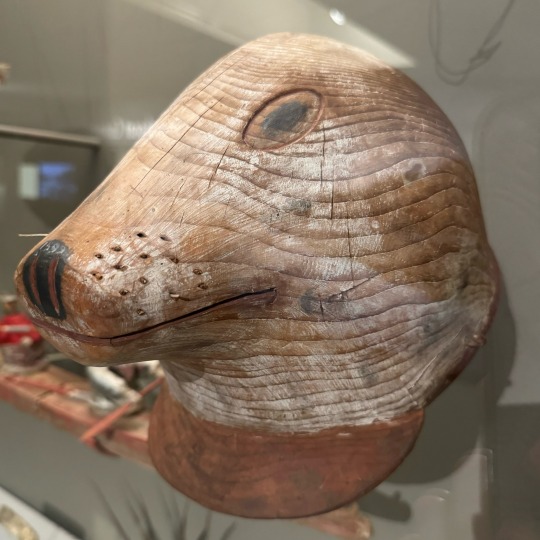
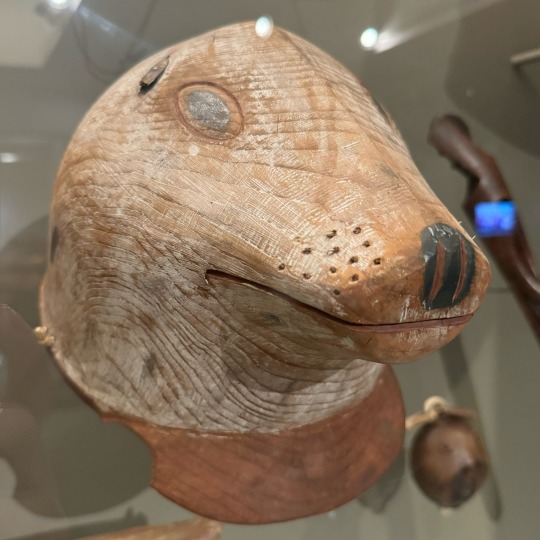
Seal Decoy Helmet
Alutiiq (Pacific Eskimo), Kodiak Island, Alaska, before 1869
Carved & painted spruce wood, inlay whiskers, 17.5 x 25.5 x 19 cm (6 7/8 x 10 1/16 x 7 1/2 in.)
Harvard Peabody Museum 69-30-10/64700
“Carved from wood, hunters would have worn this hat to approach and trap seals.”
#animals in art#animal holiday#museum visit#19th century art#seal#woodwork#Indigenous art#Native American art#First Nations art#Alaskan art#Alutiiq#decoy helmet#carving#International Day of the Seal#Harvard Peabody Museum
21 notes
·
View notes
Text
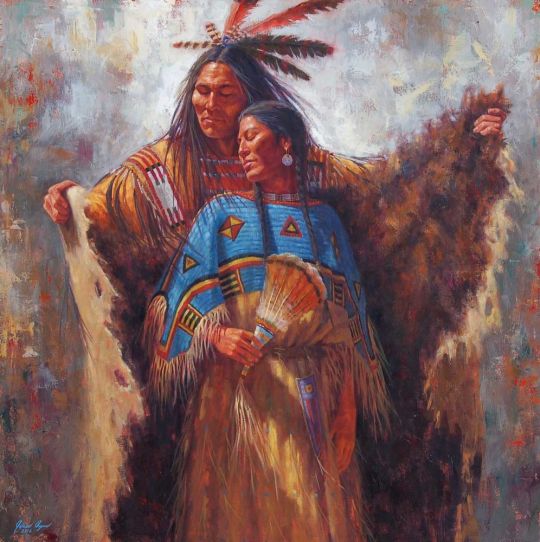
«I love you» in different Native American languages
Qunukamken = I love you (Alutiiq Language, Alaska)
Chiholloli = I love you (Chickasaw, Oklahoma)
Ayóó’áníínísh’ní = I love you (Diné, Navajo, Arizona/New Mexico)
Moo ‘ams ni stinta = I love you (Klamath-Modoc, Oregon)
Ktaʔwãanin = I love you (Mahican Dialect, Stockbridge-Munsee Tribe of Wisconsin)
Konnorónhkwa = I love you (Mohawk, New York)
In ‘ee hetewise = I love you (Nimiipuutimpt, Nez Perce Tribe, Idaho)
Nu Soopeda U = I love you (Northern Paiute, Nevada)
Gizaagiin = I love you (Ojibwa/Bad River Ojibwe, Wisconsin)
Kunoluhkwa = I love you (Oneida Tribe, Wisconsin)
Thro sii muu = You are dear to me (Pueblo of Acoma, Acoma Keres dictionary, New Mexico)
Eee-peinoom = I love you (Pueblo of Isleta, New Mexico)
Amuu-thro-maa = I love you (Pueblo of Laguna, Laguna Keres dictionary, New Mexico)
Shro- tse-mah = I love you (Pueblo of San Felipe, San Felipe Keres dictionary, New Mexico)
‘Ho’doh’ee’cheht’mah = I love you (Pueblo of Zuni, New Mexico)
Kʷ in̓x̣menč = I love you (Salish, Washington)
Gönóöhgwa’ = I love you (Seneca Tribe, New York)
Ixsixán = I love you (Tlingit, Alaska)
I daat axajóon — I’m dreaming of you (Tlingit, Alaska)
Ma ihkmahka — I love you (to a male) (Tunica, Tunica-Biloxi Tribe of Louisiana)
Hɛma ihkmahka — I love you (to a female) (Tunica, Tunica-Biloxi Tribe of Louisiana)
#Native American#NativeAmerican#Alutiiq#Chickasaw#Diné#Navajo#Klamath-Modoc#Mahican#Mohawk#Nimiipuutimpt#Paiute#Ojibwa#Ojibwe#Oneida#Acoma#PuebloofIsleta#PuebloofLaguna#PuebloofSanFelipe#PuebloofZuni#Salish#Seneca#Tlingit#Tunica#Love#Amor#foryou#parati#fyp#foryoupage
6 notes
·
View notes
Text
who wants to go to the met museum and yell about stolen indigenous art with me bc WEW i’m heated
#was just doing a ‘fun’ little deep dive on the diker collection at the met#which is a collection of over 100 pieces of indigenous american art#what do you know there’s a whole lot of art with very questionable history#like.#15% of the 139 pieces have clear ownership histories#and these pieces are ceremonial alutiiq masks and funerary quivers and arrows from the apache#they belong with their people and the met only started reaching out After the objects were on display#i’m so fucking mad about this#genuinely furious how is this okay
6 notes
·
View notes
Text
¿Historias cortas para no dormir y así no tener pesadillas? ¿Paisajes: los colores de Alaska?
Alaska (en aleutiano, Alax̂sxax̂; en iñupiaq, Alaasikaq; en alutiiq, Alas'kaaq; en yupik, Alaskaq; en tlingit, Anáaski) es uno de los cincuenta estados que forman los Estados Unidos de América.

Su capital es Juneau y su ciudad más poblada es Anchorage. Está ubicado en el extremo noroeste de América del Norte, en la región Oeste del país, división Pacífico. Limita al norte con el océano Ártico, al este con Canadá, al sur con el océano Pacífico y al oeste con el mar de Bering (océano Pacífico).
#Alaska (en aleutiano Alax̂sxax̂; en iñupiaq Alaasikaq; en alutiiq Alas'kaaq; en yupik Alaskaq; en tlingit Anáaski) es uno de los cincuenta e#¿Historias cortas para no dormir?
0 notes
Text



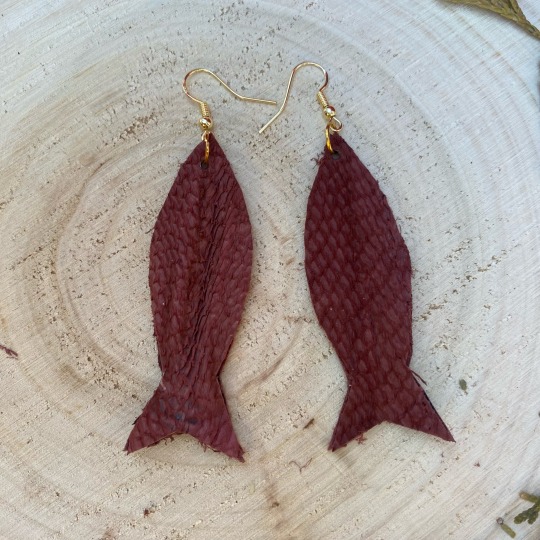
fish made from fish leather, this is a new material for me, i got it from an Alutiiq tribal member who makes it herself from salmon.
47 notes
·
View notes
Text

I wasn't sure what to draw and didn't feel like being too complicated, so here's ND, squeezing him squashing him twisting him. A good stress reliever I would know because I do this all the time
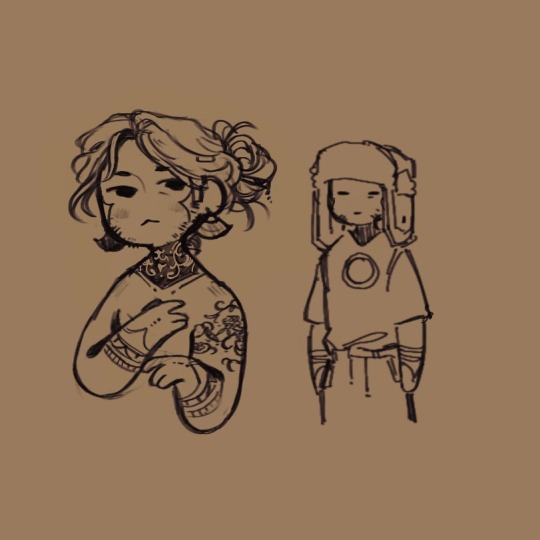
😌 also this was just me playing around with some random tattoos for Alaska, dunno if i'll keep it or not. As for his gender, and the nuance between all his cultures, the simplest I can say is that to me he could be third gender, which there is many nuance towards it because he has so many different cultures, but for now i'll go with the Sugpiaq/Alutiiq term, arnauciq, or basically, "two persons united in one" and can do both roles that are viewed as equal in communities.
I am currently making a doc for all my findings towards gender in Alaskan culture since there is a lot, so ermm just tell me if you ever wanna see it cuz why not 🤷 I just wanna be respectful as I do it hence all the research
#alaska is containing all his gender under a t shirt and hat 😢#wttt#welcome to the table#welcome to the statehouse#ben brainard#wttt fan art#wttt fanart#wttt headcanons#wttsh#wttt north dakota#wttsh north dakota#wttt alaska#wttsh alaska#wttsh fanart
93 notes
·
View notes
Text
Woven artifacts far older than previous examples show just how old the rich weaving traditions of the Alutiiq culture of Alaska are.
40 notes
·
View notes
Note
Hello! I'm really curious, what books/authors would you recommend to someone who's new to writing horror?
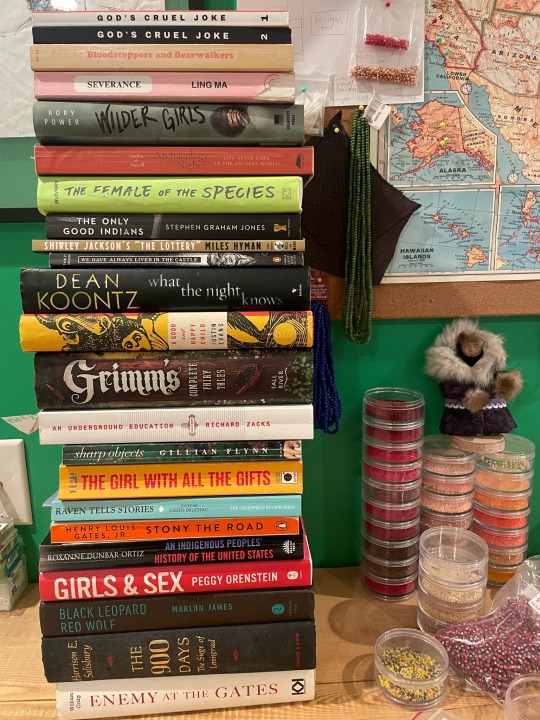
Hi! Here is what I have on hand (minus my loaned out copies of my favorite book ever Mongrels by Stephen Graham Jones and Never Whistle At Night: an indigenous anthology of dark fiction which made me cry on an airplane and made the person next to me very uncomfortable, like she was just trying to build a cart at banana republic, apologies to seat 17B)
God’s Cruel Joke Lit Mag because I’m in them and will be in issue 4, too :) published either mid-January or February 2024– @labyrinthphanlivingafacade is in issue 3 with a great short story that I won’t spoil ***right now the magazines are available to purchase in physical copies but I was told all issues will be free to download as pdfs pretty soon!
Severance by Ling Ma (body horror but not in the way you think, the real horror is repetition and loneliness)
Wilder Girls by Rory Power (body horror)
The Female of the Species by Mindy McGinnis (adjacent the horror genre but a hell of a read)
ANYTHING BY STEPHAN GRAHAM JONES ANYTHING
We Have Always Lived in a Castle by Shirely Jackson (I read this for the first time last spring boy howdy, I also included The Lottery for its suspense)
Dean Koontz because my husband suggested it for the list— this was just the first title I grabbed, I think he said Patrician Crowell too but I was busy looking for Mongrels
A Good and Happy Child by Justin Evans (I didn’t finish this because depression set in shortly after I started but the first chapter plays with second pov which I really liked, I’m determined to read it this year)
Sharp Objects by Gillian Flynn (I really enjoyed HBO’s adaptation)
The Girl With All The Gifts by M.R. Carey (likely the only zombie stories that made me weep uncontrollably)
Girls & Sex by Peggy Orenstein (non-fiction: explores modern young women navigating sexuality and because I have a thing for loss of autonomy— it’s been a few years since I read it but there is discussion of sexual assault, but I appreciate the expanse of her research and even included a conversation with someone who is asexual)
Black Leopard Red Wolf by Marlon James (got a chill just typing this out— the audio book is exquisite)
You’ll notice some nonfiction because, as a historian undergrad, nothing scares me more than man. The battles of Leningrad and Stalingrad are particularly stomach churning. America’s Reconstruction Era is full of acted out malice and under taught in my opinion.
An Indigenous People’s History of the United States by Roxanne Dunbar-Ortiz
The 900 Days, The Siege of Leningrad by Harrison E. Salisbury
Enemy at the Gates by William Craig
(On the other side of WW2 I have a book of the experiences of German solider’s left over from a paper I wrote on the inadequacy of Nazi uniforms and how it expedited their failure in Russia, Frontsoldaten by Stephen G. Fritz)
Stony the Road by Henry Louis Gates, Jr (one of my favorite authors, try finding “How Reconstruction Still Shapes American Racism” Time Magazine, April 2, 2019, I used it as a source for a paper on the history of voting rights)
Bloodstoppers and Bearwalkers— folk tales of Canadians, Lumberjacks & Indians by Richard M. Dorson (published around 1952 but content collected from the Upper Peninsula of Michigan in the 40’s)
Raven Tells Stories: An Anthology of Alaskan Native Writing (I’m Alutiiq and the museum on Kodiak has a lot of stories recorded under Alutiiq Museum Podcast— my kids and I listen on Spotify)
I think the genre of horror is really mastering tension and playing on peoples fears which is why I included old school folk stories (An Underground Education had a great write up on the Grimm Brothers and the original fairy tales from around the world such as the Chinese and Egyptian Cinderella, as well as several different sections of funny tales, torture techniques, absolute weirdos etc etc) in this vein of thought The Uses of Enchanment: The Meaning and Importance of Fairy Tales by Bruno Bettelheim could prove to be useful
If you’re writing a character with Bad Parents— Adult Children of Emotionally Immature Parents and Toxic Parents (it has a longer subtitle but I don’t see my copy anywhere) might be able to help you shape character traits
I reached out to @littleredwritingcat who has a mind plentiful in sources who recommended
The Gathering Dark: an anthology of folk horror (I will be picking this one up asap)
Toll by Cherie Priest (southern gothic)
Anything by Jennifer MacMahon
The Elementals by Michael McDowell
#book recommendations#answered#is that my ask box tag? I never get them and forget everytime lmao#I feel like I should have prefaced this with how I’m just dipping my toes into horror myself#so I’d love to hear what other people are reading too!!!!
27 notes
·
View notes
Text
ok since a couple people were wondering in the tags I'll explain where I referenced Sokka and Yue's outfits from here under the cut :]


for Sokka I mostly referenced Aleut/Alutiiq/Unangan clothes (think Aleutian Islands, Alaska, Northwest Coast - thereabouts)



for Yue I referenced Haida/Tlingit/Northwest Coast clothes, specifically this gorgeous apron and shawl combo from the Stonington Gallery which u should soooo check out. I chose this inspo for Yue cus A) its gorge and B) there were like clearly Northwest inspired Totem Poles at the Northern Water Tribe so I wanted to include that element in my pre-uni designs instead of just Mongolian/Siberian elements (which I do loooove seeing in Yue fanart btw iykyk)
as with like. ALL of my atla fashion art I've clearly taken extreme creative liberties with the clothes, because essentially they're fantasy setting clothes and I'm not gonna act like they're not lol. you should def research Northwest Coast clothing if you're into clothes like I am tho because there's plenty of historical resources and modern artists out there
Also while I'm here... go watch Sgaawaay K'unna >:) its good
44 notes
·
View notes
Quote
Stepping into the Metropolitan Museum of Art, Shyanne Beatty was eager to view the Native American works that the art collectors Charles and Valerie Diker had been accumulating for nearly half a century. But as she entered the museum’s American wing that day in 2018, her excitement turned to shock as two wooden masks came into view.
Beatty, an Alaska Native, had worked on a radio documentary about the two Alutiiq objects and how they and others like them had been plundered from tribal land about 150 years ago. Now, the masks were on display in the biggest and most esteemed art museum in the western hemisphere. “It was super shocking to me,” she said.
The Met’s ownership history for the masks, also known as provenance, omits more than a century of their whereabouts. Historians say the masks were taken in 1871. But the museum’s timeline doesn’t start until 2003, when the Dikers bought them from a collector. Ownership was transferred to the Met in 2017.
ProPublica review of records the museum has posted online found that only 15% of the 139 works donated or loaned by the Dikers over the years have solid or complete ownership histories, with some lacking any provenance at all. Most either have no histories listed, leave gaps in ownership ranging from 200 to 2,000 years or identify previous owners in such vague terms as an “English gentleman” and “a family in Scotland”.
Where did the Metropolitan Museum of Art get its Native American objects? | New York | The Guardian
86 notes
·
View notes
Text
27 notes
·
View notes
Text
Hetalia ocs I would kill to see (or see more of), in no particular order:
Chukotka
The Yup'ik
Alutiiq/Sugpiag
Sápmi
Occitania
Mongolia
Syria
Armenia
Georgia
Kyivan Rus' (or Ukraine as Kyivan Rus')
Nahua
Persia/Iran
Kurdistan
Manchu/Manchuria
Inuit peoples (Iñupiat, Inuvialuit, Inughuit etc)
Inca
Ethiopia
...... I want a lot, okay?
32 notes
·
View notes
Text
¿Historias cortas para no dormir y así no tener pesadillas? ¿Paisajes: los colores de Alaska?
Alaska (en aleutiano, Alax̂sxax̂; en iñupiaq, Alaasikaq; en alutiiq, Alas'kaaq; en yupik, Alaskaq; en tlingit, Anáaski) es uno de los cincuenta estados que forman los Estados Unidos de América.

Su capital es Juneau y su ciudad más poblada es Anchorage. Está ubicado en el extremo noroeste de América del Norte, en la región Oeste del país, división Pacífico. Limita al norte con el océano Ártico, al este con Canadá, al sur con el océano Pacífico y al oeste con el mar de Bering (océano Pacífico).
#Alaska (en aleutiano Alax̂sxax̂; en iñupiaq Alaasikaq; en alutiiq Alas'kaaq; en yupik Alaskaq; en tlingit Anáaski) es uno de los cincuenta e#¿Historias cortas para no dormir?
0 notes
Text
Environmental Victory for Alaska Natives
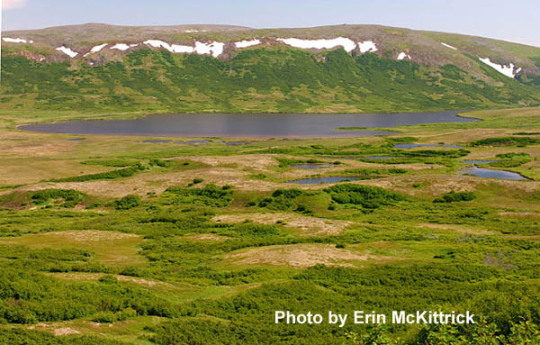
On January 8th, the U.S. Supreme Court rejected the State of Alaska's bid to fast-track the legal process, overrule the Environmental Protection Agency (EPA), and gain approval for the Pebble Mine -- slated to extract enormous amounts of copper, gold, and molybdenum from the pristine and sensitive ecosystem known as Bristol Bay. Located in a remote, wild, and generally uninhabited part of Southwest Alaska, Pebble is the largest known undeveloped copper ore body in the world.
The populations in the area rely heavily on wild resources for subsistence, harvesting moose, caribou and salmon. Wild resources play an important part in the region's cultural heritage. There are more than 30 Alaskan native tribes in the region that depend on salmon to support their traditional subsistence ways of life, in addition to other inhabitants and tourists in the area. A diverse coalition led by Alaska Natives has consistently fought against the proposed mine for more than two decades. It eventually gained support from the EPA, which ultimately blocked the mine proposal in January 2023 over concerns it would threaten an aquatic ecosystem supporting the world's most prolific sockeye salmon fishery.
This decision is significant, particularly considering the current High Court's tendency to support states' rights, limits on regulation -- especially of the environmental variety -- and corporate concerns. Alaska's request, filed in June, was unusual in that it sought to skip lower appeals courts to challenge the EPA's decision on the basis that it violated Alaska's state sovereignty.
Under the law, alleged violations of state sovereignty are one of the few categories of cases that grant the Supreme Court original jurisdiction -- meaning a state can bypass the usual state/federal court appeals process and file straight with the High Court. The justices could easily have decided to hear the case and decide in favor of the mining company, which has shown no qualms about engaging in some shady business practices over the years.
As the single most productive sockeye salmon fishery in the world, Bristol Bay contains biodiversity and abundant wild fish populations which present a stark contrast to many other fisheries in the Pacific Northwest (and worldwide). All five Eastern Pacific salmon species spawn in Bristol Bay's freshwater tributaries. Most have experienced severe depletion over the last few decades. Sockeye salmon, like all Pacific Salmon, are a keystone species, vital to the health of an entire ecosystem. Of course, salmon also provide a sacred food source for Indigenous communities up and down the West Coast.
Kudos to the United Tribes of Bristol Bay, a consortium of Alaska Native tribes fighting to preserve the traditional Yup'ik, Dena'ina, and Alutiiq ways of life in Southwest Alaska, for leading the charge. The Supreme Court's decision confirms all the hard work put in by tribes and allies, including the Save Bristol Bay Coalition. It remains to be seen whether Alaska's conservative leadership will continue with legal challenges at a lower court level -- but, for now, Indigenous People have won a big battle in this decades-long fight to protect their homelands.
9 notes
·
View notes
Text
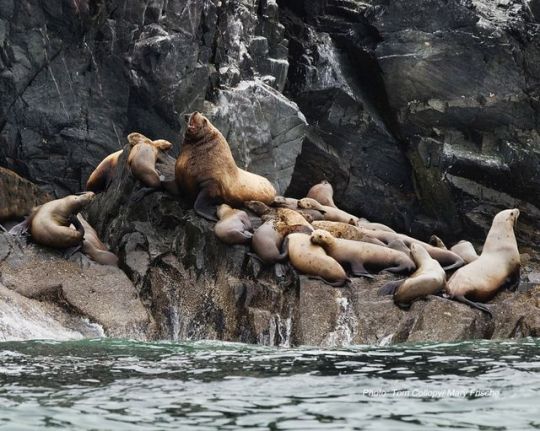
Steller Sea Lions (Eumetopias jubatus)
Known as qawax (Aleut) and wiinaq (Alutiiq), they can be found in summers in Alaska Maritime National Wildlife Refuge at their terrestrial rookeries where they mate, rest, and birth, and at haul-out sites at other times of the year when not in water.
The refuge provides the endangered western range of Steller sea lions with protected habitat like beaches, rock outcroppings, and remote islands to support their return to healthy population sizes.
Photo by Tom Collopy/Mary Frische/USFWS
Find out more:
Steller Sea Lion | NOAA Fisheries
11 notes
·
View notes